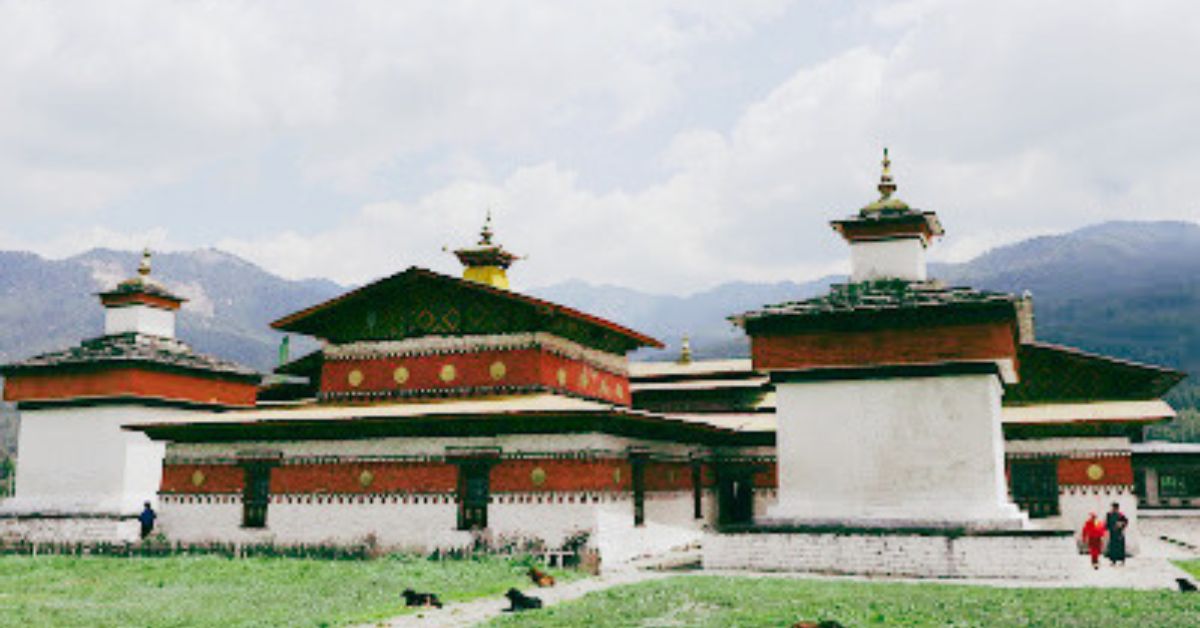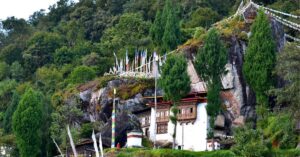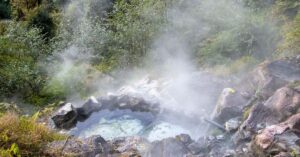Jambay Lhakhang is a one-story Temple of Maitreya founded by the 33rd Tibetan King, Songtsen Gampo, in 659 CE. It is one of the oldest temples in Bhutan, built as part of the 108 temples constructed on a single day to pin down an ogress to earth that was obstructing the spread of Buddhism.
The temple is located at Changwang village under Chhoekor Gewog of Bumthang Dzongkhag at an elevation of 2630 meters above sea level. The main statue in Jampa Lhakhang is Jowo Jampa (Maitreya), the future Buddha.
Among the 108 temples built in the Himalayan region, the well-known Lhakhangs within Bhutan are Jampa Lhakhang in Bumthang and Kyichu Lhakhang in Paro. The other lesser-known temples built by Songtsen Gampo in Bhutan are Kongchogsum in Bumthang, Khaine in Lhuntse, and Lhakhang Karpo and Lhakhang Nagpo in Haa.
The temple is named Jampa Lhakhang because it is dedicated to Jowo Jampa, the future Buddha. In the 8th century, Guru Rinpoche blessed the Lhakhang.
Jampey Lhakhang is also popular for the infamous Jambay Lhakhang Drup Festival held in October every year.
How to Reach Jambay Lhakhang
Jambay Lhakhang is located in Bumthang, the central part of Bhutan, on the way to Kurjey Lhakhang. The Lhakhang can be reached by diverting and taking a left-hand deviation off the road that goes to Kurje Lhakhang. From Paro International Airport, it takes nearly 9 hours to drive. But if you don’t have time or want to cut short the distance, you can take a domestic flight from Paro to Bathpalathang Domestic Airport in Bumthang. The flight will take no more than 45 minutes. From Bumthang Domestic Airport to Chamkhar Town, it is just a 5-minute drive. Jambay Lhakhang is approximately four kilometers from Chamkhar town and takes only 10 minutes.
If you are traveling to Jambay Lhakhang from Thimphu by car, you will take more than 7 hours. You can also directly travel from Phuentsholing to Bumthang. However, the time taken will be more than 11 hours.
Jambay Lhakhang has begun charging a monument entry fee of Nu 500 for foreign visitors. The collection began on January 1, 2026. Entry is free for children under five years of age, while a 50% concession fee is provided for children aged six to 17 years.
Sacred Relics to See at Bumthang Jambay Lhakhang
- Jowo Jampa (Maitreya), the Future Buddha;
- A hundred statues of the Gods of the Kalachakra (Dus Kyi Khorlo);
- Chorten Lhakhang;
- Jambay Lhakhang Drup;
- Mewang, fire blessing;
- Terchham, naked dance.
Also Read: Guru Rinpoche in Bhutan: His Visits to Bhutan and Sacred Sites
Historical Significance of Jambay Lhakhang
According to Jampa Lhakhang’s history, when Songtsen Gampo, the 33rd Tibetan King of the Yarlung Dynasty, was on a mission to spread Buddhism in the Himalayan region in the 7th century AD, a demoness was obstructing the spread of Buddhism. The demoness’s entire body is said to have covered Tibet and the other Himalayan regions. It is said that Songtsen Gampo was destined to subdue the demoness by constructing 108 temples known as Thadrul–Yangdhul in a day.
Following this destiny, Songsten Gampo, along with his two wives, built a series of 108 temples throughout the Himalayas in a single day, each one helping to pin down the demoness.
According to the Jambay Lhakhang history in Bhutan, the Jambay Lhakhang was built to pin down the demoness’s left knee, while the Kyichu Lhakhang was built over the left foot. Later, Guru Rinpoche blessed Jambay Lhakhang in the 8th century. Guru Rinpoche is said to have delivered the teachings of the Kagye cycle to King Sindhu Raja and his retinue from Jambay Lhakhang’s rooftop.
Also Read: Kyichu Lhakhang, the Sacred Jewel of Bhutan
King Sindhu Raja of Bumthang restored the temple after Guru Padmasambhava recovered the life force (sog) of Sindhu Raja, which the local deity, Shelging Karpo, had snatched. Therefore, Jambay Lhakhang remains one of Bhutan’s holiest and oldest temples.
Importance of Jampa Lhakhang
Jambay Lhakhang is one of Bhutan’s oldest temples, founded by Songtsen Gampo in 659 CE. It was one of the 108 temples built on a single day, to pin down an ogress to earth forever who was obstructing the spread of Buddhism. According to many historians, Buddhism came to Bhutan for the first time when Jampa Lhakhang was established in the country.
Jambay Lhakhang’s importance is also due to the visit by Guru Rimpoche, who blessed the temple and preached the teachings of the Kagye cycle to King Sindhu Raja and his court. Moreover, statues of Guru Rinpoche and Jowo Jampa are said to have once spoken.
Description of Jambay Lhakhang
The oldest Jambay Lhakhang is the Jokhang, which was built in 659 CE. Later, Sendha Gyalpo restored the Lhakhang after the Guru Rinpoche returned his Sog snatched by Shelging Karpo. A circumambulating area and small prayer wheels around the outer walls of the Jokhang were built by notable figures in different historical periods. Although the structures appear to be a single complex, they differ from one another in architectural features like the Rabsel, payabs, etc.
Jampa Lhakhang Complex
The present-day Jambey Lhakhang is a single-storey complex. The main statue of Jampa Lhakhang is Jowo Jampa. Jokhang is surrounded by a courtyard formed by the construction of four sanctuaries in the middle of the 19th century. Duki Khorlo or Dukhor (Kalacakra) sanctuary on the right side of the main sanctuary, forming the north courtyard, was built by Jigme Namgyal and Gongsar Ugyen Wangchuck. The sanctuary is to honor their triumph against Phuntsho Dorji of Punakha and Alu Dorji of Thimphu following the Changlimithang War in 1885. A Goenkhang was also built by the first king, Ugyen Wangchuck, near the Dukhor sanctuary.
Later, the Jambay Lhakhang complex was partially restored by Jakar Dzongpon Chime Dorje, the brother-in-law of the first king, Ugyen Wangchuck, in 1905.
Chorten Lhakhang
The Choeten Lhakhang at the north is an extension of the Duki Khorlo Lhakhang built by Ashi Wangmo. This Lhakhang is dedicated to the 1st Benchey Lama, the reincarnation of Karmapa. A Chorten is located in the center of the Lhakhang. The painting of Karmapa’s lineage and the Thirty-five Buddhas of Confession are painted on the right and left walls, respectively.
Guru Lhakhang
The Guru Lhakhang on the left side of the courtyard in the south direction was founded by Jakar Dzongpon Tsondru Gyeltsen in the mid-19th century. Guru Rinpoche, flanked by Avalokiteshvara and Amitayus, is the main statue of Guru Lhakhang. Twenty-one Taras are painted on the right wall, and the left-hand wall is Avalokiteshvara with a thousand eyes and hands. There is also a painting of the great master Pema Lingpa on the right side of the window, and on the left is the protective deity Gonpo Maning, one aspect of Mahakala.
Sangay Rabduen Lhakhang
Sangye Rabduen Lhakhang, located toward the east above the complex main entrance, was founded by the second King Jigme Wangchuck. It is the Lhakhang of Buddha, and the main statue represents the Buddha of the Seven Ages. The paintings on the right wall depict the esoteric cycle of the Gondu, while the left wall has the paintings of Guru Rinpoche and his eight manifestations, Avalokiteshvara, and the Medicine Buddha.
Jangchub Chorten Zhi
The Jangchub Chorten Zhi, or the Four Jangchub Chortens, is said to have been constructed by King Songtsen Gampo along with Jampa Lhakhang. They all have a stone pinnacle and are all constructed with stone as the main material, and also mud plaster. These Chortens are located at each corner of Jampa Lhakhang and represent the four guardian deities.
The four Chortens are built in different forms and painted in different colors. A white Chorten on the eastern side of the Lhakhang has a four-sided base, trapezoidal center, and a dome on top. The yellow Chorten at the south has a form similar to the Chortens built around the center. A western red stupa is similar to the yellow Chorten but with a different shape of dome. The northern green Chorten is similar to the eastern white Chorten but has a square part in the center.
Every year during the Jambay Lhakhang Drup, mask dancers go to each Chorten and commit to shoulder the responsibility of guarding the locality.
Jambay Lhakhang Drup Festival
Jambay Lhakhang Drub Festival is a five-day annual festival held in the courtyard of Jambay Lhakhang to commemorate the construction of the Lhakhang and in honor of Guru Rinpoche, who consecrated the Lhakhang. It is annually held from the 15th to the 19th of the 9th Bhutanese month as per the Bhutanese calendar. During this festival, many colorful masked dances and other rituals mark the festival. The mask dances are performed by the locals of Norgang, Changwa, and Nangsiphel.
Mewang or Fire Blessing and Tercham or Naked Dance are the main highlights of the Jambay Lhakhang Drup festival. Both of these programs take place at night on a full moon day. During the fire blessing ceremony, the devotees jump over the flames to cleanse their sins. The locals believe that passing through the fire offering will eliminate all the obstacles. Some people also believe that the purpose of the fire blessing is to bless infertile ladies and enable them to become pregnant.
Tercham, or the Naked Dance, is another popular dance among devotees. Except for a tiny piece of cloth that they use to conceal their faces, the dancers are indeed nude. This naked dance was introduced by Terton Dorji Lingpa to divert the attention of demons who delayed the construction of a monastery by destroying it every night.
Also Read: Nabji Lhakhang Drup of Trongsa Nabji Lhakhang
Best Time to Visit Bumthang Jambay Lhakhang
Jambay Lhakhang is a must-visit on your trip to Bhutan since it offers a journey through time and heritage. There is no better time to visit Jambay Lhakhang. However, the best seasons would be spring and autumn.
If you want to witness the most popular festival held in the temple, you must plan to visit in October. Every October, the temple celebrates a renowned festival called Jambay Lhakhang Drup. You can visit the major pilgrimage sites of Bumthang with the Bhutan Pilgrimage Package.
Frequently Asked Questions
Where is Jambay Lhakhang located?
Jambay Lhakhang is located in the Bumthang Valley of central Bhutan.
Who built Jampa Lhakhang?
The 33rd Tibetan King, Songtsen Gampo, built Jampa Lhakhang in 659 CE.
Why was Jampa Lhakhang built?
Jampa Lhakhang was built as part of the 108 temples to pin down an ogress to earth that was obstructing the spread of Buddhism.
Which is the main statue in Jampa Lhakhang?
The main statue in Jampa Lhakhang is Jowo Jampa (Maitreya), the future Buddha.
What is the significance of Jampa Lhakhang?
Jambay Lhakhang has great significance in the spread of Buddhism and Bhutan. Firstly, Jambay Lhakhang was built as part of the 108 temples to pin down an ogress to earth that was obstructing the spread of Buddhism by Songtsen Gampo in 659 CE. Secondly, Jambay Lhakhang was blessed by Guru Rinpoche in the 8th century. Thirdly, Royal patronage has glorified the temple over time.
Who introduced Jambay Lhakhang Drup?
The Jambay Lhakhang Drup festival was introduced to commemorate the establishment of the Jambay Lhakhang temple in the 7th century and to honor Guru Rinpoche.
Can tourists attend the Jambay Lhakhang Drup festival?
Yes, the Jambay Lhakhang Drup festival is open to both locals and tourists.
Enjoyed reading this blog?




